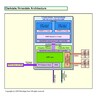Intel Core 2 Duo P9600 vs Intel Core i5-520UM
Intel Core 2 Duo P9600
► remove from comparison
The Intel Core 2 Duo P9600 was a upper middle class dual core CPU for laptops, at the time of introduction. It is similar to the Core 2 Duo T9550 except for the lower TDP of 25 versus 35 Watt).
Due to the relatively high clock speed and 6MB Level 2 cache, the P9600 offers enough performance for demanding games (in 2009) and applications. The newer Core i3-330M should deliver a similar performance due to the hyperthreading support.
The P9600 uses a Penryn (Montevina Update) core that features 2 integer units, 1 floating point unit, 1 load unit, and 1 store unit in a 14-stages long pipeline. Due to the Wide Dynamic Execution Technology, the core is able to simultaneously execute up to four instructions.
The integrated Enhanced Speedstep is able to downclock the core dynamically to save power (in idle mode).
Intel Core i5-520UM
► remove from comparison
The Intel Core i5-520UM is a Ultra Low Voltage dual-core processor for small and light laptops. It is clocked with 1.06 - 1.86 GHz (if Turbo Boost is enabled). Each core is based on the Nehalem (Westmere) micro-architecture. Hyperthreading enables the Dual Core CPU to handle 4 threads at once (for a better usage of the pipeline). Compared to the Core i7-620UM, the i5 offers only 3MB Level 3 cache (i7 4MB) and a lower maximum Turbo Boost frequency. Other Core i5 CPUs (withouth the U in the name) are faster due to the higher clock speed, but need more power.
A feature of the new Core i5-520UM is the integrated graphics card (called Intel HD Graphics) and memory controller. Both are on a separate die that is still manufactured in 45nm whereas the CPU die is already manufactured in the new 32nm process.
Due to the integrated memory controller, the HyperThreading and Turbo Boost, the Core i5-520UM is faster than a similar clocked Core 2 Duo (1.2 GHz) in all (us known) applications and benchmarks. Still the Turbo Boost may not trigger very often (sometimes it is even not activated in the BIOS) and therefore the maximum of 1.86 GHz is not very important.
The 32nm cpu cores of the Westmere generation can also process some new instructions to accelerate AES encryptions. Modern applications that support AES encoding can profit significantly using the new instructions (e.g. the Communications Suite test in the PCMark Vantage boosts up to 70% using AES in the faster Core i5-520M).
The integrated Intel Graphics Media Accelerator HD (GMA HD) graphics card is between 166-500 MHz (Turbo Boost) and therefore the base speed is clearly below the non low voltage versions. The performance should still be faster than the old GMA 4500MHD.
The power consumption of 18 Watt TDP (max.) counts for the whole package and therefore it is clearly better than the 17 Watt TDP of the Core 2 Duo SL-series (CPU alone).
| Model | Intel Core 2 Duo P9600 | Intel Core i5-520UM | ||||||||||||||||||||||||||||||||||||||||||||||||||||
| Series | Intel Core 2 Duo | Intel Core i5 | ||||||||||||||||||||||||||||||||||||||||||||||||||||
| Codename | Penryn | Arrandale | ||||||||||||||||||||||||||||||||||||||||||||||||||||
| Series: Core i5 Arrandale |
| |||||||||||||||||||||||||||||||||||||||||||||||||||||
| Clock | 2660 MHz | 1060 - 1866 MHz | ||||||||||||||||||||||||||||||||||||||||||||||||||||
| FSB | 1066 | 2500 | ||||||||||||||||||||||||||||||||||||||||||||||||||||
| L1 Cache | 128 KB | |||||||||||||||||||||||||||||||||||||||||||||||||||||
| L2 Cache | 6 MB | 512 KB | ||||||||||||||||||||||||||||||||||||||||||||||||||||
| Cores / Threads | 2 / 2 | 2 / 4 | ||||||||||||||||||||||||||||||||||||||||||||||||||||
| TDP | 25 Watt | 18 Watt | ||||||||||||||||||||||||||||||||||||||||||||||||||||
| Transistors | 410 Million | 382+177 Million | ||||||||||||||||||||||||||||||||||||||||||||||||||||
| Technology | 45 nm, 1.05-1.212V | 32 nm | ||||||||||||||||||||||||||||||||||||||||||||||||||||
| Die Size | 107 mm2 | 81+114 mm2 | ||||||||||||||||||||||||||||||||||||||||||||||||||||
| max. Temp. | 105 °C | 105 °C | ||||||||||||||||||||||||||||||||||||||||||||||||||||
| Socket | PGA478 | BGA1288 | ||||||||||||||||||||||||||||||||||||||||||||||||||||
| Features | Virtualization Technology (VT-x), Trusted Execution, Intel 64, Enhanced Speedstep, Execute Disable Bit | Turbo Boost (1.86 GHz max), Hyper Threading, Enhanced Speedstep, integrated GMA HD 166-500MHz | ||||||||||||||||||||||||||||||||||||||||||||||||||||
| Architecture | x86 | x86 | ||||||||||||||||||||||||||||||||||||||||||||||||||||
| $348 U.S. | $241 U.S. | |||||||||||||||||||||||||||||||||||||||||||||||||||||
| Announced | ||||||||||||||||||||||||||||||||||||||||||||||||||||||
| Manufacturer | ark.intel.com | ark.intel.com | ||||||||||||||||||||||||||||||||||||||||||||||||||||
| L3 Cache | 3 MB |


 Deutsch
Deutsch English
English Español
Español Français
Français Italiano
Italiano Nederlands
Nederlands Polski
Polski Português
Português Русский
Русский Türkçe
Türkçe Svenska
Svenska Chinese
Chinese Magyar
Magyar